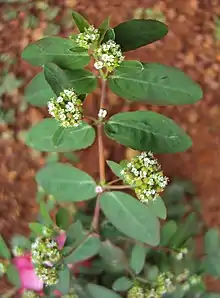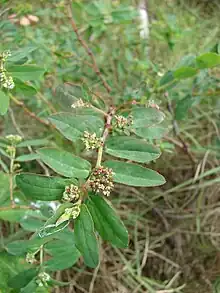| Euphorbia hypericifolia | |
|---|---|
 | |
| Scientific classification | |
| Kingdom: | Plantae |
| Clade: | Tracheophytes |
| Clade: | Angiosperms |
| Clade: | Eudicots |
| Clade: | Rosids |
| Order: | Malpighiales |
| Family: | Euphorbiaceae |
| Genus: | Euphorbia |
| Species: | E. hypericifolia |
| Binomial name | |
| Euphorbia hypericifolia | |
| Synonyms[2][3][4][5][6] | |
| |
Euphorbia hypericifolia (commonly known as graceful spurge, golden spurge, and chickenweed) is a species of perennial herb in the genus Euphorbia native to tropical Americas. It normally grows up to 2 feet (0.6 m) in height, and contains milky sap which can cause skin and eye irritation.[7][8]
Description
Plant hairless on all parts, stems generally about 50 cm (rare outliers to 170 cm), obviously arching, few to many, with flowers and fruit capsules as conspicuous dense balls held a distance from the stem (FNA). (Confusion with other species such as E. hyssopifolia/nutans may occur where the balls have few flowers in which case they will lack interspersed leaves.)
Distribution

The plant is native to Tropical Americas like most Euphorbias, the place where it is native includes Southern most parts of U.S, Mexico, West Indies, Central and South America.[9]
The places where this plant is an introduced species includes Spain, Italy, Greece, Indian subcontinent, China, South Korea, Myanmar, and parts of Indonesia as well as Subsaharan Africa.[10]
References
- ↑ "NatureServe Explorer 2.0". explorer.natureserve.org.
- ↑ Quattrocchi, Umberto (April 19, 2016). CRC World Dictionary of Medicinal and Poisonous Plants: Common Names, Scientific Names, Eponyms, Synonyms, and Etymology (5 Volume Set). CRC Press. ISBN 9781482250640 – via Google Books.
- ↑ Nowick, Elaine (October 11, 2014). Historical Common Names of Great Plains Plants, with Scientific Names Index: Volume II: Scientific Names Index. Lulu.com. ISBN 9781609620608 – via Google Books.
- ↑ Brummitt, R.K. (2001). World Geographical Scheme for Recording Plant Distributions (PDF) (2nd ed.). Taxonomic Databases for Plant Sciences (TDWG). Archived from the original (PDF) on 2016-01-25.
- ↑ "Euphorbia hypericifolia L. GRIN-Global".
- ↑ Linné, Carl von; Salvius, Lars (July 11, 1753). Caroli Linnaei ... Species plantarum :exhibentes plantas rite cognitas, ad genera relatas, cum differentiis specificis, nominibus trivialibus, synonymis selectis, locis natalibus, secundum systema sexuale digestas... Vol. 1. Impensis Laurentii Salvii.
- ↑ "Euphorbia hypericifolia (Baby's-breath Euphorbia, Fluxweed, Garden Spurge, Graceful Sandmat, Graceful Spurge, Large-spotted Spurge) | North Carolina Extension Gardener Plant Toolbox". plants.ces.ncsu.edu.
- ↑ "Euphorbia hypericifolia | International Plant Names Index". www.ipni.org.
- ↑ Brummitt, R.K. 2001. TDWG – World Geographical Scheme for Recording Plant Distributions, 2nd Edition
- ↑ "Euphorbia hypericifolia L. | Plants of the World Online | Kew Science". Plants of the World Online.
